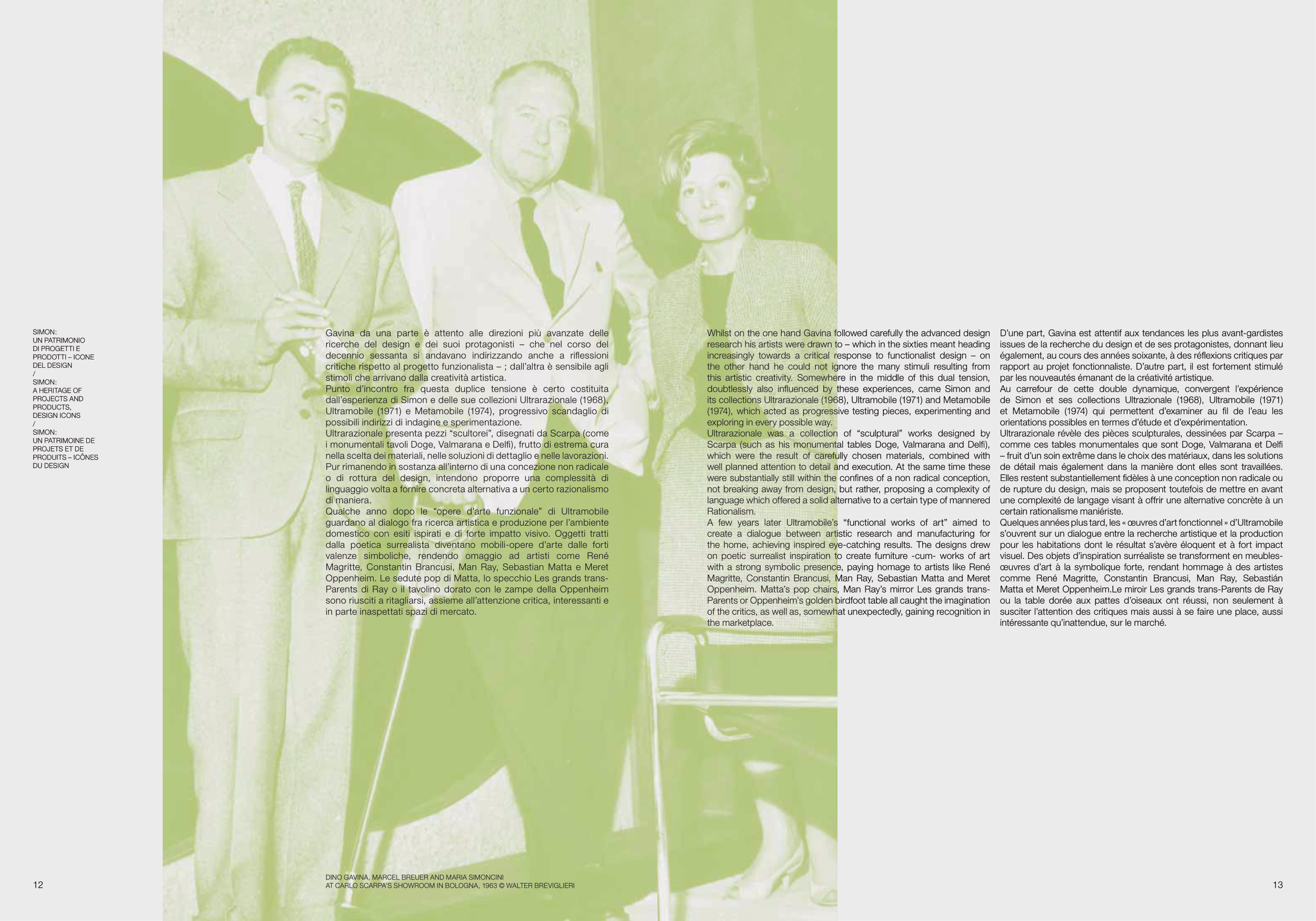Gavina da una parte è attento alle direzioni più avanzate delle
ricerche del design e dei suoi protagonisti – che nel corso del
decennio sessanta si andavano indirizzando anche a riflessioni
critiche rispetto al progetto funzionalista – ; dall’altra è sensibile agli
stimoli che arrivano dalla creatività artistica.
Punto d’incontro fra questa duplice tensione è certo costituita
dall’esperienza di Simon e delle sue collezioni Ultrarazionale (1968),
Ultramobile (1971) e Metamobile (1974), progressivo scandaglio di
possibili indirizzi di indagine e sperimentazione.
Ultrarazionale presenta pezzi “scultorei”, disegnati da Scarpa (come
i monumentali tavoli Doge, Valmarana e Delfi), frutto di estrema cura
nella scelta dei materiali, nelle soluzioni di dettaglio e nelle lavorazioni.
Pur rimanendo in sostanza all’interno di una concezione non radicale
o di rottura del design, intendono proporre una complessità di
linguaggio volta a fornire concreta alternativa a un certo razionalismo
di maniera.
Qualche anno dopo le “opere d’arte funzionale” di Ultramobile
guardano al dialogo fra ricerca artistica e produzione per l’ambiente
domestico con esiti ispirati e di forte impatto visivo. Oggetti tratti
dalla poetica surrealista diventano mobili-opere d’arte dalle forti
valenze simboliche, rendendo omaggio ad artisti come René
Magritte, Constantin Brancusi, Man Ray, Sebastian Matta e Meret
Oppenheim. Le sedute pop di Matta, lo specchio Les grands trans-
Parents di Ray o il tavolino dorato con le zampe della Oppenheim
sono riusciti a ritagliarsi, assieme all’attenzione critica, interessanti e
in parte inaspettati spazi di mercato.
D’une part, Gavina est attentif aux tendances les plus avant-gardistes
issues de la recherche du design et de ses protagonistes, donnant lieu
également, au cours des années soixante, à des réflexions critiques par
rapport au projet fonctionnaliste. D’autre part, il est fortement stimulé
par les nouveautés émanant de la créativité artistique.
Au carrefour de cette double dynamique, convergent l’expérience
de Simon et ses collections Ultrazionale (1968), Ultramobile (1971)
et Metamobile (1974) qui permettent d’examiner au fil de l’eau les
orientations possibles en termes d’étude et d’expérimentation.
Ultrarazionale révèle des pièces sculpturales, dessinées par Scarpa –
comme ces tables monumentales que sont Doge, Valmarana et Delfi
– fruit d’un soin extrême dans le choix des matériaux, dans les solutions
de détail mais également dans la manière dont elles sont travaillées.
Elles restent substantiellement fidèles à une conception non radicale ou
de rupture du design, mais se proposent toutefois de mettre en avant
une complexité de langage visant à offrir une alternative concrète à un
certain rationalisme maniériste.
Quelques années plus tard, les « œuvres d’art fonctionnel » d’Ultramobile
s’ouvrent sur un dialogue entre la recherche artistique et la production
pour les habitations dont le résultat s’avère éloquent et à fort impact
visuel. Des objets d’inspiration surréaliste se transforment en meubles-
œuvres d’art à la symbolique forte, rendant hommage à des artistes
comme René Magritte, Constantin Brancusi, Man Ray, Sebastián
Matta et Meret Oppenheim.Le miroir Les grands trans-Parents de Ray
ou la table dorée aux pattes d’oiseaux ont réussi, non seulement à
susciter l’attention des critiques mais aussi à se faire une place, aussi
intéressante qu’inattendue, sur le marché.
Whilst on the one hand Gavina followed carefully the advanced design
research his artists were drawn to – which in the sixties meant heading
increasingly towards a critical response to functionalist design – on
the other hand he could not ignore the many stimuli resulting from
this artistic creativity. Somewhere in the middle of this dual tension,
doubtlessly also influenced by these experiences, came Simon and
its collections Ultrarazionale (1968), Ultramobile (1971) and Metamobile
(1974), which acted as progressive testing pieces, experimenting and
exploring in every possible way.
Ultrarazionale was a collection of “sculptural” works designed by
Scarpa (such as his monumental tables Doge, Valmarana and Delfi),
which were the result of carefully chosen materials, combined with
well planned attention to detail and execution. At the same time these
were substantially still within the confines of a non radical conception,
not breaking away from design, but rather, proposing a complexity of
language which offered a solid alternative to a certain type of mannered
Rationalism.
A few years later Ultramobile’s “functional works of art” aimed to
create a dialogue between artistic research and manufacturing for
the home, achieving inspired eye-catching results. The designs drew
on poetic surrealist inspiration to create furniture -cum- works of art
with a strong symbolic presence, paying homage to artists like René
Magritte, Constantin Brancusi, Man Ray, Sebastian Matta and Meret
Oppenheim. Matta’s pop chairs, Man Ray’s mirror Les grands trans-
Parents or Oppenheim’s golden birdfoot table all caught the imagination
of the critics, as well as, somewhat unexpectedly, gaining recognition in
the marketplace.
SIMON:
UN PATRIMONIO
DI PROGETTI E
PRODOTTI – ICONE
DEL DESIGN
/
SIMON:
A HERITAGE OF
PROJECTS AND
PRODUCTS,
DESIGN ICONS
/
SIMON:
UN PATRIMOINE DE
PROJETS ET DE
PRODUITS – ICÔNES
DU DESIGN
DINO GAVINA, MARCEL BREUER AND MARIA SIMONCINI
AT CARLO SCARPA’S SHOWROOM IN BOLOGNA, 1963 © WALTER BREVIGLIERI
12
13


